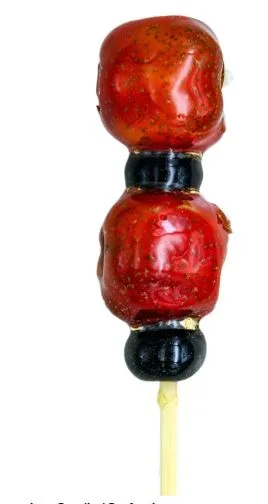Crimson Glaze & Tangy Zing: Unwrapping the Hawthorn Tanghulu Enigma
A Glimpse into Candied Perfection
The world of culinary delights is vast and varied, but few treats capture the imagination quite like the vibrant, glossy skewers known as tanghulu. Among its many iterations, the hawthorn tanghulu stands out as a true masterpiece, a delicate dance between tartness and sugary sweetness that has captivated palates for centuries. More than just a snack, it’s a cultural icon, a symbol of festive joy and simple pleasures. The satisfying crackle of the candy shell giving way to the soft, tangy fruit beneath is an experience that transcends mere taste, inviting you into a rich tapestry of tradition and flavor. This beloved confection, particularly the authentic hawthorn variety, offers a unique sensory journey.
The Ancestral Roots of Tanghulu
The history of tanghulu is as rich and layered as its candied coating. Originating in Northern China, this delightful treat boasts a heritage stretching back centuries. Legend has it that tanghulu was first created during the Southern Song Dynasty (1127-1179 AD) when a concubine of Emperor Guangzong fell ill. Traditional remedies proved ineffective until a physician prescribed hawthorn berries boiled with brown sugar. The concubine recovered, and the sweet and sour concoction quickly gained popularity among the populace. Initially a medicinal remedy, it soon transformed into a cherished street food, evolving from simple candied hawthorn to encompass a variety of fruits. The core principle, however, remained: fresh fruit encased in a translucent, brittle sugar shell. This enduring popularity speaks volumes about its timeless appeal and ability to adapt while retaining its essential charm.
The Art of Crafting Hawthorn Tanghulu
Creating the perfect hawthorn tanghulu is an art form, a delicate balance of temperature, timing, and technique. While seemingly simple, mastering the craft requires precision. The primary ingredients are straightforward: fresh hawthorn berries, sugar, and water.
Essential Steps:
- Selecting the Hawthorn: The quality of the berries is paramount. Choose plump, firm hawthorn berries, ideally with a vibrant red hue, indicating ripeness and optimal flavor. They should be free from blemishes and soft spots.
- Preparing the Fruit: Each hawthorn berry must be meticulously cleaned. The small, tough core and seeds are traditionally removed, a painstaking process that ensures a smoother eating experience. Some modern variations may leave the seeds in, but for true authenticity and ease of consumption, removal is preferred.
- Skewering: The prepared hawthorn berries are then carefully threaded onto bamboo skewers. Typically, five to seven berries adorn each skewer, creating an appealing visual and manageable portion. Uniform spacing is key for even coating.
- The Sugar Syrup: This is the heart of the tanghulu. Granulated sugar and water are combined in a specific ratio and heated gently. The mixture is stirred until the sugar dissolves completely, then brought to a boil. The crucial stage is reaching the “hard crack” stage, where a drop of the syrup plunged into cold water immediately solidifies into a brittle, glass-like thread. This precise temperature (approximately 300-310°F or 149-154°C) is vital for the signature crunch.
- Dipping and Cooling: Once the syrup reaches the perfect consistency, each skewer of hawthorn is swiftly dipped into the molten sugar, ensuring an even and thin coat. Excess syrup is allowed to drip off before the coated skewers are placed on a greased surface or parchment paper to cool and harden. The cooling process is rapid, typically taking only a few minutes, resulting in the iconic glossy, brittle shell.
The Unique Flavor Profile
What sets hawthorn tanghulu apart is its distinctive flavor profile. The hawthorn berry itself possesses a unique tartness, a sharp, almost puckering acidity that is beautifully counterbalanced by the sweet, crackling sugar coating. This interplay creates a harmonious contrast – a sweet initial crunch followed by a burst of tangy fruit. The hawthorn also offers subtle floral and earthy undertones, adding complexity to the overall experience. It’s a flavor that is both refreshing and comforting, making it a beloved treat across generations. Unlike other candied fruits that might be overwhelmingly sweet, the hawthorn’s natural acidity provides a welcome palate cleanser, preventing the sweetness from becoming cloying.
Beyond the Traditional: Variations and Modern Interpretations
While traditional hawthorn tanghulu holds a special place, the versatility of the concept has led to numerous variations. Other fruits commonly used include:
- Strawberries
- Grapes
- Mandarin oranges
- Kiwi
- Blueberries
- Pineapple chunks
Some vendors also experiment with less common fruits or even add nuts and sesame seeds to the outer coating for added texture and flavor. Modern interpretations might even involve chocolate drizzles or different flavored sugar syrups, though these are deviations from the classic. Despite the innovations, the original hawthorn tanghulu remains the benchmark, cherished for its authentic taste and historical significance. The beauty of tanghulu lies in its adaptability, allowing for creative culinary exploration while maintaining its fundamental appeal.
Cultural Significance and Festive Appeal
Tanghulu, and especially hawthorn tanghulu, is deeply intertwined with Chinese culture and festivities. It is a quintessential street food, particularly popular during colder months and at traditional festivals like the Chinese New Year. Its vibrant appearance and sweet taste make it a perfect symbol of celebration and good fortune. Vendors often sell tanghulu from pushcarts, creating a lively atmosphere as the sweet aroma wafts through the air. It’s a treat enjoyed by people of all ages, evoking nostalgic memories for adults and creating new ones for children. The act of sharing tanghulu with loved ones during a festive gathering is a cherished tradition, adding to its cultural importance. It embodies the joy of simple pleasures and shared experiences.
The Perfect Pairing
While delicious on its own, hawthorn tanghulu also pairs wonderfully with certain beverages. Its sweetness and tartness make it an excellent accompaniment to:
- Hot Tea: Traditional Chinese teas, particularly green tea or oolong, provide a warm, slightly bitter counterpoint that cleanses the palate and enhances the tanghulu’s flavors. The warmth of the tea also contrasts beautifully with the crisp, cool candy.
- Warm Water: A simple glass of warm water can help refresh the mouth and appreciate the distinct flavors without interference.
- Mildly Sweetened Beverages: Beverages with a subtle sweetness, like a light fruit juice or even plain sparkling water, can complement without overpowering the tanghulu. Avoid overly sweet drinks that might compete with the tanghulu’s own sugary coating.
A Timeless Treat for All Seasons
Though often associated with winter, hawthorn tanghulu can be enjoyed year-round. Its refreshing tang and satisfying crunch make it a delightful treat even in warmer weather. It’s a testament to its enduring appeal that it transcends seasonal boundaries. Whether you’re seeking a nostalgic taste of tradition, a unique dessert experience, or simply a sweet and sour pick-me-up, hawthorn tanghulu offers a sensory adventure that is both familiar and exciting. Its simple elegance and profound flavor continue to charm palates around the globe, cementing its status as a timeless culinary treasure. The experience of biting into a perfectly crafted tanghulu is a small moment of joy, a reminder of the simple yet profound pleasures found in traditional snacks.
Conclusion
From its humble beginnings as a medicinal remedy to its status as a beloved street food and festive treat, hawthorn tanghulu has carved a unique niche in the culinary world. Its irresistible combination of tart hawthorn berries and a crisp, sugary shell creates an unforgettable taste sensation. It’s a treat that not only delights the taste buds but also carries with it the echoes of history and the warmth of cultural tradition. Whether you encounter it on a bustling street corner in Beijing or recreate it in your own kitchen, the magic of hawthorn tanghulu is undeniable. Its enduring popularity is a testament to its simple perfection, a sweet symphony that continues to captivate hearts and palates. For those interested in exploring more about traditional Chinese confectionery and its diverse forms, further insights can often be found by delving into resources on the rich history of Chinese cuisine.
FAQ’s about Hawthorn Tanghulu
Q1: What exactly is hawthorn tanghulu?
A1: Hawthorn tanghulu is a traditional Chinese candied fruit snack made by skewering fresh hawthorn berries and dipping them in a hot sugar syrup, which then hardens into a clear, brittle coating.
Q2: What does hawthorn tanghulu taste like?
A2: It offers a unique combination of flavors: the outer sugar shell is sweet and crunchy, while the hawthorn berry inside is distinctively tart and slightly tangy, creating a balanced sweet-and-sour profile.
Q3: Is tanghulu difficult to make at home?
A3: While the ingredients are simple, achieving the perfect “hard crack” stage for the sugar syrup requires precision and attention to temperature. It can be challenging for beginners but is rewarding to master.
Q4: Can I use other fruits for tanghulu?
A4: Yes, while hawthorn is traditional, tanghulu can be made with various other fruits like strawberries, grapes, mandarin oranges, kiwi, and blueberries.
Q5: What is the cultural significance of tanghulu?
A5: Tanghulu is a popular street food in China, especially during winter and traditional festivals like Chinese New Year. It is enjoyed by all ages and is a symbol of celebration and simple pleasures.
Q6: How should I store leftover tanghulu?
A6: Tanghulu is best consumed fresh, as the sugar coating can become sticky or melt over time due to humidity. If you must store it, place it in an airtight container in a cool, dry place for a very short period, but refrigeration is generally not recommended as it can make the candy shell gummy.
Q7: Are hawthorn berries healthy?
A7: Hawthorn berries are known in traditional Chinese medicine for various potential health benefits, including supporting digestion and cardiovascular health. However, in tanghulu, the added sugar means it should be enjoyed as a treat in moderation.



